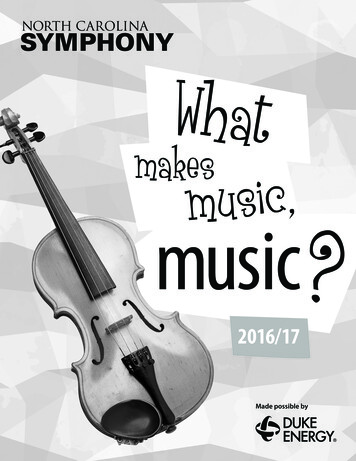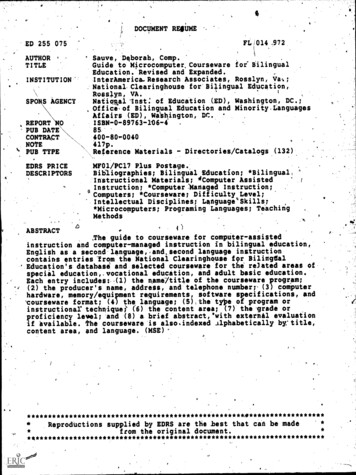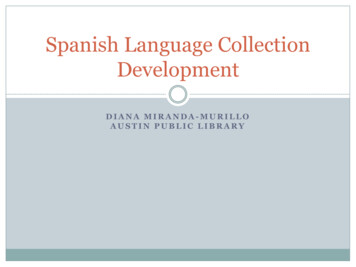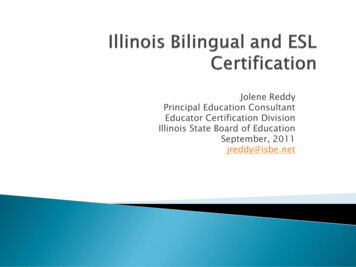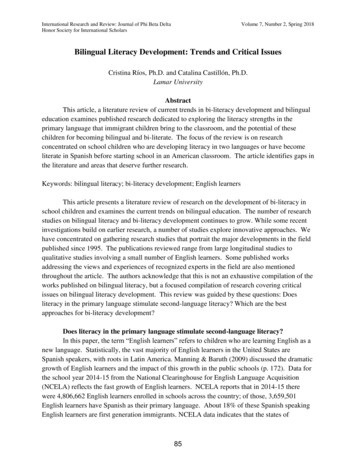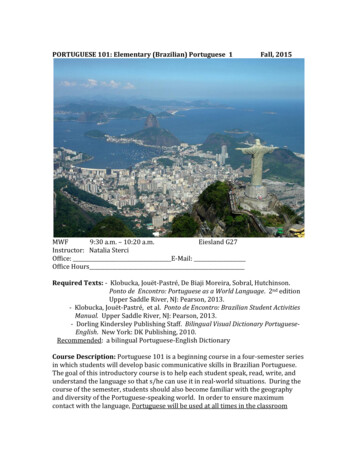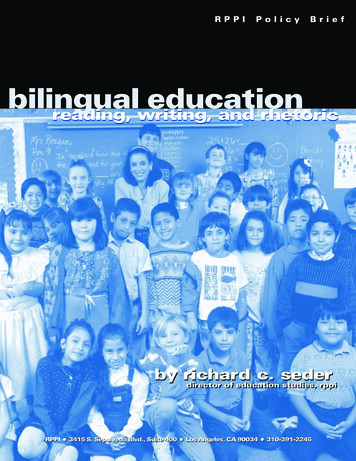
Transcription
RPPIPolicyBriefbilingualeducationreading, writing, and rhetoricby richard c. sederdirectordirector ofof educationeducation studies,studies, rppirppiRPPI l 3415 S. Sepulveda Blvd., Suite 400 l Los Angeles, CA 90034 l 310-391-2245
Glossaryof Terms17EndnotescontentsRPPIabout RPPIThe Reason Foundation is a national research and educational organization thatexplores and promotes the twin values ofrationality and freedom as the basic underpinnings of a good society. Since 1978,the Los Angeles-based foundation has provided practical public policy research,analysis, and commentary based upon theprinciples of individual liberty and responsibility and limited government.Reason Public Policy Institute (RPPI), a division of the Reason Foundation, fusestheory and practice to influence public policies. The Institute's research draws uponeconomics, science, and institutional analysis to critique public policies and advancenew policy ideas in a variety of policy areas, including education, infrastructure andtransportation, the environment, urbanland use and local economic development,social services, and privatization and government reform.To that analysis, the Institute brings a political philosophy that supports rule of law, marketplace competition,economic and civil liberty, personal responsibility in social and economic interactions, and institutional arrangementsthat foster dynamism and innovation.The Reason Foundation is a tax-exempt educational organization as defined under IRScode 501(c)(3).The Reason Foundation neither seeks nor accepts government funding, and is supported by individual, foundation and corporate contributions. Nothingappearing in this document is to be construed as necessarily representing theviews of the Reason Foundation or its trustees, or as an attempt to aid or hinder thepassage of any bill before any legislativebody.Photos used in this publication are Copyright 1996. Photodisc, Inc. Copyright 1998.Reason Foundation.All Rights Reserved.about the authorRichard C. Seder is the director of education studies for the Reason Public Policy Institute, a national public policyresearch organization. Mr. Seder has done extensive work in the area of quantitative and qualitative research on thestructure of educational systems; school choice programs; accountability issues; and the impact of expenditures onstudent achievement. Before joining RPPI, Mr. Seder worked as a research assistant to the executive director for theCato Institute inWashington, D.C., where he assisted in a study analyzing the relationship between public and privatepost-secondary institutions in three states. Prior to that, he was the recipient of a Charles G. Koch Fellowship throughthe Center of Market Processes examining the effects of immigration on the U.S. economy. Additionally, Mr. Seder hasserved as a project director for the Allegheny County School System in Pennsylvania, where he conducted extensive research on 43public school districts. Mr. Seder holds a Masters of Science in Public Policy and Management from the Heinz School at Carnegie MellonUniversity in Pittsburgh as well as a double bachelors degree in Government and Economics from Beloit College in Wisconsin.
Executive SummaryExecutiveHow best to serve limited-English proficient (LEP) students has been at thecenter of both the pedagogical andpolitical struggle known as bilingual educationfor more than 30 years. The eyes of the country are focusing on California and what manyconsider the future of bilingual education.Over 1.3 million students are classified as limited-English proficient in California, nearly 40percent of the nation’s LEP population. Upuntil February 1998, the state mandated theuse of native language instruction to educateLEP students. However, for a variety of reasons, approximately 30 percent of LEP students received the majority of their academicinstruction in their native language, while 16percent received no special instructional services at all.Because of data limitations and the generallack of evaluation, dropout rates and othereducational measures do not differentiate between those students who received specialinstructional services and those that have not.The lack of comprehensive data lends itself tomisrepresentation, by both bilingual educationproponents and opponents.Research on the effectiveness of bilingual education is at best inconclusive. Both sides ofthe debate over the use of native-languageinstruction cling to the research results thatsupport their particular argument. However,few research studies go without questionssurrounding methodology, sample, or in theinterpretation of results.Consensus of research conclusions in favor ofone methodology over another is unlikely giventhe diverse nature of these students — languages, family and community backgrounds,prior education and English exposure — andthe diverse circumstances that school districtsface. To expect such a result would ignorethe complexities surrounding the issue.Given the conflicting research results of bilingual education and the diverse population oflimited-English proficient students and schools,one “best” instructional program should not bemandated across all schools and districts.Instead, state and federal policymakers shouldprovide districts the opportunity to innovatewith instructional programs to properly meetthe needs of LEP students. At the same time,policymakers should incorporate evaluation andaccountability components into their policies toensure that those instructional programsadopted are effective.IntroductionThe questions of whether limited-Englishproficient children should receive special educational services, to what extent school districts are responsible for providingthose services, and what type of special servicesshould be provided has been a matter of publicdiscourse for more than 30 years. Limited-Englishproficient students, while first protected and provided for by Title VI of the Civil Rights Act of1964, and later by Title VII of the Elementaryand Secondary Education Act of 1968, have beenat the center of both the pedagogical and political struggle known as bilingual education.With over three million students designated aslimited-English proficient (LEP), and nearly 40percent of those students located in California,how to meet the educational needs of thesestudents remains controversial. What instructional practice, or practices, work? And whatdoes “work” mean? Should schools concentrate solely on English proficiency as quickly aspossible? If so, are sacrifices made and timelost in the other academic subjects, and whatis the quickest way to get these students English-proficient? What methods get LEP students at a par with native-English speakersacross all subject areas? Is it appropriate tothink in terms of one-best program at all, givendiverse goals and needs?bilingual education117
Obscured in the political rhetoric is the termbilingual education. What constitutes bilingual education instruction? The various sidesof the debate clutch to their anecdotal andempirical evidence that definitively proves thatbilingual education is either a rousing successor a dismal failure. Estimates of the expenditures on providing special services range fromnot-nearly-sufficient to an extraordinary andgrowing burden on state and local resources.BackgroundA. StudentsDuring the 1994-95 school year, over threemillion students across the nation were classified as limited-English proficient, or LEP. California alone serves over 1.3 million LEP children, nearly a 50 percent increase from 1990and nearly four times as many as in 1980,constituting more than one of every five stuCan both sides of the argument be correct in dents in California schools, and representing39.9 percent of the nation’s total LEP populatheir assertions?tion.2 While the issue of serving limited-EnWhat is clear in the debate is the need to meet glish proficient students faces every state, overthe special circumstances of this diverse and 75 percent of the nation’s LEP population aregrowing population.1 Both bilingual education located in four states, California, Texas, Newproponents and opponents agree that account- York, and Florida (see Table 1).ability in the current system is almost nonexistent. Both sides agree that poorly imple- In California, over 100 languages and dialectsmented programs are resulting in the failure are spoken by students attending elementaryto provide a meaningful education to these and secondary schools. There is a heavy concentration of LEP students in elementarystudents.school, with over 69 percent in grades K-6.This policy brief provides a brief overview of: More than 40 percent of these LEP studentscan be found in the early kindergarten throughn the status of limited-English proficient stu- third grade (Figure 1).dents;While the task seems daunting, over 80 percent of these students speak Spanish, andn the nature and definition of services beingnearly 92 percent speak Spanish, Vietnamadministered;ese, Tagalog (Phillipines), Korean, Hmong,Khmer (Cambodia), and Cantonese.3n the policies that govern how these students are served; andGiven the growth in this segment of the student population, comparison to previous genn a synopsis of research evaluating the ef- erations of immigrants and the type of edufectiveness of special instructional services cation that they received proves difficult. Fullprovided to LEP students with an empha- English immersion may have been the onlysis on California.option available, and had some success withLEP students, given the relatively small numThe purpose is not a pedagogical endorsement bers in the schools. Given the small numof one form of instruction over another. Rather, bers, more personalized attention may havethe purpose is to provide an objective under- been given to these students both within thestanding of the issues for sound policymaking classroom and through peer coaching. Reat the local, state, and federal levels, and by gardless, in the 1960’s, nearly 50 percent ofparents concerned about the nature of services Mexican-American LEP youth did not combeing provided to their children.plete the eighth grade.482Reason Public Policy Institute
B. Federal Court Decisions, Laws,olicyand PPolicyThe issues of whether or not to provide special services and what kind of services to provide to limited-English proficient students arespelled out in federal and state laws, courtrulings, and policies and regulations.Limited-English proficient students were firstrecognized under federal law under Title VIof the Civil Rights Act of 1964. Title VI ensures equal educational opportunities for students by requiring that there be no discrimination on the basis of race, color, or nationalorigin in the operation of any federally assisted programs.dent population. The act was recently reauthorized in 1994 under the ImprovingAmerica’s Schools Act (IASA).The basis for the continued reauthorization ofthe Bilingual Education Act rests with federaland U.S. Supreme Court decisions. Perhaps thetwo most influential decisions regarding the provision of special services to LEP students arethe 1974 Lau and 1981 Castaneda decisions.Based on the inclusion of limited-English proficient students under Title VI of the Civil RightsAct, the U.S. Supreme Court, in 1974, decided in Lau v. Nichols that an equal education is not provided if non-English-speakingstudents cannot understand the teachers, textbooks, or curriculum, in this case Chinese stuTo meet the specific needs of LEP students, dents in San Francisco.5Title VII of the federal Elementary and Secondary Education Act of 1968, also known In the Lau case, the Court did not detail a speas the Bilingual Education Act, was estab- cific remedy or pedagogical solution. Instead,lished to provide funding for various educa- it deferred to Department of Health, Education programs to meet the needs of this stu- tion, and Welfare guidelines:STATES WITH THE LARGEST LEP ENROLLMENTS, 1994–95LEP EnrollementNat’l Enrollment %Cumulative %1,262,98239.9%39.9%2. Texas457,43714.5%54.4%3. New York236,3567.5%61.8%4. Florida153,8414.9%66.7%5. Puerto Rico*143,7694.5%71.2%6. 0.4%52,0811.6%82.0%51,5981.6%83.7%1. California7. Arizona8. New Mexico9. New Jersey10. Washingtontable 1Source: Data is from the SEA Survey forms submitted by the SEAs. *Limited SpanishProficient is used in place of Limited-English Proficient for Puerto Rico.bilingual education13
Where inability to speak and understand theEnglish language excludes national origin-minority group children from effective participation in the educational program offered by a 2 .school district, the district must take affirmative steps to rectify the language deficiencyin order to open its instructional program tothese students.6By leaving the specifics out, the Supreme Courtallowed for flexibility on the part of school districts to meet the needs of its student populations. However, further clarification wasneeded to determine whether or not the services being provided were adequate by a school.or that is recognized as a legitimate educational strategy.The school must have programs, policies,and resources in place that could be reasonably expected to implement effectivelythe chosen educational theory.3 . The school’s program must demonstratethat students are making progress in overcoming language barriers. No matter howreasonable a school’s original choice ofprogram may be or how exhaustive arethe resources dedicated to the program,the failure of students to make progressobligates the school to revise its program.7In 1981, a federal court set out in Castanedav. Pickard guidelines for determining whethera school had met its obligations under federallaw to provide adequate special services.These guidelines became the federal threeprong test, which included:According to interpretation by California’sLittle Hoover Commission, “This decision alsomade it clear that while schools must havetwo goals — helping students attain Englishproficiency and ensuring that they make academic progress in the overall curriculum —1 . The school must create a program for non- the schools are free to pursue the goals seEnglish-speaking students based on an quentially rather than simultaneously.”8 Thiseducational theory that is recognized as allowed districts to choose and implementsound by at least some experts in the field programs that may sacrifice a student’s over-GRADE LEVEL OF STUDENTS NOT FLUENT IN ENGLISHUngraded 1.29%10-12 11.29%K-3 44.93%7-9 18.25%figure 14-6 24.24%Source: CA State Department of Education, 1997.84Reason Public Policy Institute
all academic learning with respect to nativeEnglish speakers while learning English. However, parity with native-English speakers byLEP students must be achieved within somereasonable time upon entering the school.71 of the California Education Code. In 1967,this statutory mandate was repealed by Senate Bill 53. In 1976, the state enacted theChacon-Moscone Bilingual/Bicultural EducationAct, followed by the Bilingual Education Improvement and Reform Act of 1980.Title VII instructional programs have focusedon the dual purpose set out in Castaneda:In 1987, the California bilingual education lawwas allowed to “sunset” with the intention ofThe Congress finds that (8) it is theproviding school districts the flexibility to depurpose of this title to help ensure thatsign and implement instructional programs forlimited English proficient students maslanguage-minority students otherwise not alter English and develop high levels oflowed under the strict standards of the existacademic attainment in content area;9ing law. While the law was allowed to sunset,In 1994-95, approximately 300,000 limited- the California Department of Education issuedEnglish proficient students nationwide re- “advisories” to school districts. These advisoceived their education through Title VII-funded ries stated that school districts must continueinstructional programs, roughly nine percent to comply with the “general and intended purof the total LEP population. Five major in- poses” of the original law, Education Code12structional programs are designed to serve 52161, thus rendering the sunset policy moot.LEP students under Title VII (the number inparentheses denotes the percentage of totalLEP students receiving that particular programin 1994-95): Transitional Bilingual Education(6 percent), Developmental Bilingual Education (0.3 percent), Special Alternative Instructional Program (2 percent), Family LiteracyProgram (0.1 percent), and the Special Populations Program (1 percent).10The California Department of Education andBoard of Education set requirements that schooldistricts were to meet, similar to the three-prongtest outlined in Castaneda and allowing for flexibility at the district level outlined in Lau. Inshort, the guidelines required districts to provide an instructional program that taught LEPstudents English, that provided equal academicopportunity, and to provide the necessary reTitle VII grants are provided on a competitive sources to effectively implement the program,basis. These grants have tended to favor both fiscally and through personnel.programs that utilize native-language instruction, but since 1984, a portion of Title VII However, the department enforced a specificfunds — 25 percent — may go to support type of program that emphasized native-lanalternative, all-English approaches (included guage instruction as the preferred method ofin Special Alternative Instructional Plans).11 education for LEP students. This was doneThese funds serve a capacity-building purpose through the Coordinated Compliance Reviewthat allows districts to implement new pro- process in which districts had to satisfy 12grams that eventually become self-support- requirements. Below are some of the requireing. However, it must be noted that the cap ments that essentially mandated native-lanof 25 percent to non-native-instructional plans guage instruction:creates undesirable incentives when designing new instructional plans for language-mi- n Place students who do not speak Englishfluently into a program of instruction innority students.English language development.C. California Lawn Give each student primary-language accessto the core curriculum (based on the level ofFrom 1872 until 1967, California law requiredproficiency in English and native language).all instruction to be in English under Section15
nMake specially designed academic instruction in English available to those studentswho are advanced enough in English towarrant it.instructional program. The waiver doesnot dismiss the district from federal requirements. Approximately 300 districtsqualify for this option;nAssign an adequate number of “qualified” 6 . Small and scattered LEP populations—ifteachers to implement the English lana district has fewer than 51 and no singleguage-development program.school has more than 20 students in aparticular language group, the district isn Assign an adequate number of “qualified”exempt from meeting the compliance reteachers to implement the primary-lanview for that language group. About 850guage-instruction program.13districts qualified for this option for oneor more language groups.14Districts that did not meet the twelve requirements set forward by the department were Two major developments occurred in 1998provided six options:that have dramatically changed the way dis1 . Demonstration of educational results—allows a school to adopt an alternative-instructional program, but the school mustbe able to prove that students perform ata level equal to or greater than the statewide averages. The burden of proof is uponthe district and requires additional resources dedicated to the department’sevaluation process;tricts provide special educational services tolimited-English proficient students.In February 1998, a Sacramento SuperiorCourt judge ruled, in a case involving an Orange County school district, that the intentof the state’s expired bilingual education lawwas to “effectively and efficiently as possibledevelop in each child fluency in English(Chacon-Moscone Bilingual/Bicultural Educa2 . Assignment of teachers with Commission tion Act)” and that primary-language instrucon Teacher Credentialing (CTC) authoriza- tion was not required and that the state boardtions—deals with qualifications of teach- was wrong in requiring districts to obtain15ers, all staff have special certificates is- waivers from native-language instruction.sued by the Commission on TeacherCredentialing. Five hundred districts chose On March 12, 1998, the California StateBoard of Education, following the lead ofthis option in 1991-92;Judge Ronald Robie’s decision, voted unani3 . Local designation of other qualified teach- mously to rescind its long-standing policiesers—districts may set up their own of requiring native-language instruction to LEPcredentialing program for staff under de- students. The vote allows school districts topartment review;decide the instructional programs for LEP students at the local level, including English-only4 . Plan to remedy shortage of qualified teach- programs, without obtaining waivers from theers—if a school district has made every at- state. While districts are no longer requiredtempt to obtain the specified number of quali- to comply with California mandates, they arefied instructors and comes up short, the dis- still required to comply with federal law.trict can devise a plan to remedy the situation over a specified period of time. Some D. California Funding490 districts chose this option in 1991-92;Failure to comply with the state requirements5 . General waiver authority—if Option 4 fails,or satisfy the department through one or morethe district may request a waiver from thatof the available options, in the past, resultedspecific requirement, or for an alternative-86Reason Public Policy Institute
in delays, and potential loss, of Economic Impact Aid (EIA) funding targeted for educationally disadvantaged and limited-English proficient students.Over 300 million is allocated through theEIA program. Many times, LEP students alsoqualify for educationally disadvantaged funding as well. Because of this designation, manyLEP students qualify for federal Title I funding that targets at-risk students.Costs for providing special instructional services to LEP students are estimated to beroughly equal to those costs of regular instructional programs.16 Little is actuallyknown about the true costs of providing special instructional services to LEP studentsbecause of the block grant nature of fundsdisseminated to the schools, such as thestate’s EIA program. In many instances, thesefunds are pooled together in the school’s operation budget without specification to particular program areas.17 This allows schoolsthe flexibility to meet the specific needs ofits student body.Special InstructionalPrograms for LimitedEnglish ProficientStudentsA. California ParticipationParticipationWhile there is some overlap in definitions between some of the program models, there isalso overlap in the implementation of theseprograms as well. However, in most studies, schools often identify their program under one of the general categories. Table 2illustrates instructional services provided toCalifornia LEP students.Dropout rates for Hispanic students in theUnited States are higher at 12.4 percent in1995 compared to 4.5 percent for whites and6.4 percent of blacks (California dropoutrates: 5.6% for Hispanics; 2.4% for whites;and 6.6% for blacks).19 While this figure represents LEP and English-fluent Hispanics, thosestudents speaking Spanish at home (again notan accurate indication of English fluency) weremore likely to have repeated at least onegrade.20 However, we should be hesitant todesignate the dropout rate as an indication thatbilingual education has failed. Hispanics tendto drop out more, not because of academicachievement (4 percent). Rather, 38 percentof Hispanic dropouts gave economic reasons(desire to work, financial difficulties, home responsibilities) for dropping out.21 Also, verylittle research has disaggregated the dropoutfigure according to instructional practices received.In 1996-97, 16 percent of limited-English proficient students did not receive any special instructional services. This is primarily due tothe scattered language populations, exempting schools from offering special instructionalservices. Only 29.7 percent of California LEPstudents received the majority of their academic instruction in their native language. Anadditional 21.6 percent of LEP students received some native-language support fromsome type of aide. The remaining students(32.7 percent) received English instruction asthe primary mode of academic instructioncoupled with ESL instruction with no nativelanguage assistance.22According to an analysis of instructional programs implemented to serve LEP students doneby Development Associates, Inc., it is primarily districts with large numbers of LEP students (1,000 or more) that tend to have moreintensive native-language-instructional programs, where native-language instruction isused 50 percent of the day or more.23 It isprimarily through state funding programs (75percent or more) that these same districts provide their chosen instructional program.24For example, the way that California’s LEPprogram is funded, through the Economic Impact Aid program, districts have extra incentive to classify students as non-proficient inbilingual education17
English. This is also true for many other stateand federal programs, such as the federalgovernment’s Title I program. Because of thisincentive structure, closer analysis must bedone with regards to the number of studentsclassified as limited-English proficient, as wellas the reclassification, or redesignation rate,the rate at which LEP students are no longerconsidered limited-English proficient (see Figure 2). Classification may sometimes proveto be a financial decision made on the parts ofschool and district administrators rather thana pedagogical decision.Research ResultsResultsA. Bilingual Education Programs DoNot Work Workork Strong criticism is being made of bilingual education programs across the country. Anti-bilingual education stories center around thetransitional and developmental bilingual education program models, those that utilize native-language instruction. Stories abound ofstudents graduating without any proficiencyin English, or Spanish, for that matter, of students being placed in inappropriate native-language classes, of parents unable to take advantage of the voluntary nature of the bilingual education programs, etc.There is good reason for concern. The number of students being classified as non-English or limited-English proficient continuesto grow as the number of students being classified as English-proficient does not.While Figure 2 is alarming, bilingual education proponents claim that traditionaltransitioning takes place anywhere from twoto seven years into the program. However,the Little Hoover Commission noted,“Whether one expects students to transitionin two, three, four, five or even six years,there is no “bulge” in the redesignation figures that accounts for the eventual transition of the hundreds of thousands of studentswho are not fluent in English.”25 Given thispattern of program achievement, thousandsof students would eventually graduate without fluency in English. But again, there maybe perverse financial incentives involved thatmay limit the official redesignation rate, allowing for actual numbers of students identified as proficient being much greater.Opponents of native-language instructionalprograms turn to the evaluative research ofChristine Rossell. Rossell, and her colleaguesJ. Michael Ross and Keith Baker, reviewed theresearch done on bilingual education, andfound that of the 300 program evaluations per-LEP INSTRUCTIONAL SERVICESNumber% of StudentsEnglish Language Development (ELD) Only158,64011.5%ELD and “Sheltered English” Instruction274,84519.9%ELD, sheltered English and primarylanguage support by paraprofessionals298,39521.6%table 2ELD and academic subjects throughthe primary language410,12729.7%Not receiving any special service*239,38617.3%1,381,393100.0%California totalsSource: California Department of Education, 1997. *includes withdrawn at parents request88Reason Public Policy Institute
formed up to the point of their research, only72 proved to be methodologically acceptable— true experimental design with random assignment to control and treatment groups,controlled for student and family characteristics, the comparison group included LEP students of the same ethnicity and language background, outcome measures did not includegrade equivalents, and additional educationaltreatments were eliminated or controlled for.Researchers continue to debate the methodological validity which Rossell used in herchoice of studies to include in her analysis.26We should also pay close attention to the nature of the evaluations done, who was tested,at what point were they tested, what werethe measured differences between programsbefore coming to the definitive conclusion thatnative-language programs are wholly ineffective. Another source of debate is the methodof vote-counting which continues to be ofTable 3 shows the comparison of transitional debate in the scientific community in makingbilingual education (TBE) to submersion, En- conclusive determinations about the effectiveglish as a Second Language instruction, and ness of competing programs.27developmental bilingual education (DBE) onsecond language reading, language, and math. Though Rossell’s analysis has some problems,it should not be completely discounted, andThe percentages in Table 3 indicate the per-
economics, science, and institutional analy- . Prior to that, he was the recipient of a Charles G. Koch Fellowship through the Center of Market Processes examining the effects of immigration on the U.S. economy.Additionally , Mr. Seder has . and had some success with LEP students, given the relatively small num-


